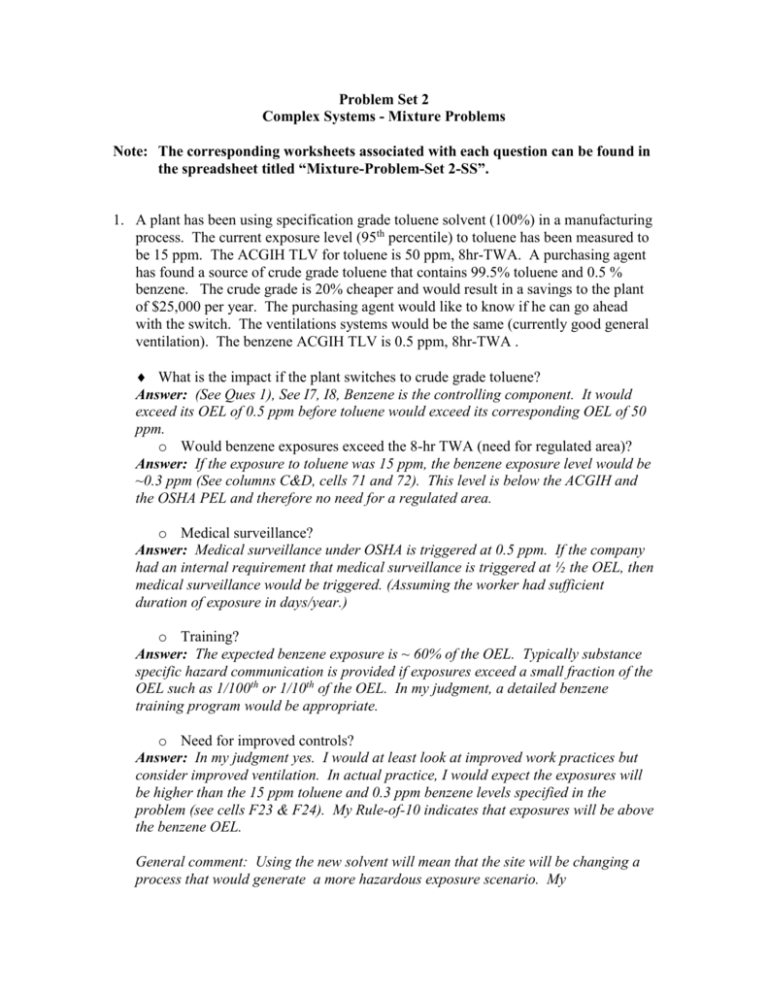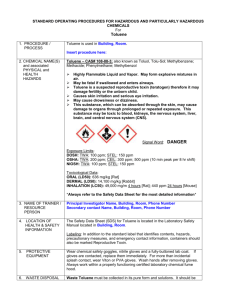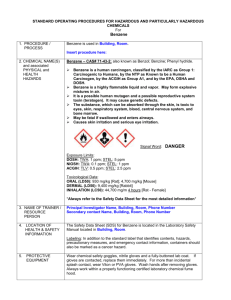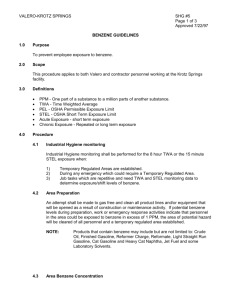Mixture Problem Set 2
advertisement

Problem Set 2 Complex Systems - Mixture Problems Note: The corresponding worksheets associated with each question can be found in the spreadsheet titled “Mixture-Problem-Set 2-SS”. 1. A plant has been using specification grade toluene solvent (100%) in a manufacturing process. The current exposure level (95th percentile) to toluene has been measured to be 15 ppm. The ACGIH TLV for toluene is 50 ppm, 8hr-TWA. A purchasing agent has found a source of crude grade toluene that contains 99.5% toluene and 0.5 % benzene. The crude grade is 20% cheaper and would result in a savings to the plant of $25,000 per year. The purchasing agent would like to know if he can go ahead with the switch. The ventilations systems would be the same (currently good general ventilation). The benzene ACGIH TLV is 0.5 ppm, 8hr-TWA . What is the impact if the plant switches to crude grade toluene? Answer: (See Ques 1), See I7, I8, Benzene is the controlling component. It would exceed its OEL of 0.5 ppm before toluene would exceed its corresponding OEL of 50 ppm. o Would benzene exposures exceed the 8-hr TWA (need for regulated area)? Answer: If the exposure to toluene was 15 ppm, the benzene exposure level would be ~0.3 ppm (See columns C&D, cells 71 and 72). This level is below the ACGIH and the OSHA PEL and therefore no need for a regulated area. o Medical surveillance? Answer: Medical surveillance under OSHA is triggered at 0.5 ppm. If the company had an internal requirement that medical surveillance is triggered at ½ the OEL, then medical surveillance would be triggered. (Assuming the worker had sufficient duration of exposure in days/year.) o Training? Answer: The expected benzene exposure is ~ 60% of the OEL. Typically substance specific hazard communication is provided if exposures exceed a small fraction of the OEL such as 1/100th or 1/10th of the OEL. In my judgment, a detailed benzene training program would be appropriate. o Need for improved controls? Answer: In my judgment yes. I would at least look at improved work practices but consider improved ventilation. In actual practice, I would expect the exposures will be higher than the 15 ppm toluene and 0.3 ppm benzene levels specified in the problem (see cells F23 & F24). My Rule-of-10 indicates that exposures will be above the benzene OEL. General comment: Using the new solvent will mean that the site will be changing a process that would generate a more hazardous exposure scenario. My recommendation is that this substitution is not a good idea and if it takes place, ventilation and work practices would have to be improved.. 2. Gaseous hydrogen chloride is used in a process to treat metal surfaces. At the end of the reaction, the process is quenched with a 20 fold excess of water. The quench water (5% HCl solution) is then sent to an open tank in the waste treatment area. What will be the estimated hydrogen chloride exposure level be to operators who must periodically gauge the open tank? Answer: There would virtually no hydrogen chloride (HCl) vapor. HCL is a strong acid and will dissociate completely in water to hydrogen ions and chloride ions and therefore the concentration of HCL is approximately zero in the solution. There is not need to use the mixture spreadsheet. General Comment: Always consider dissociation, especially in water solutions. If you do not know, ask a chemist or engineer familiar with the process. Henry’s Law is used with these aqueous solutions. 3. An IH at an Olefins Plant is concerned about exposures related to the loading process of a byproduct that typically contains 65% biphenyl and 35% toluene. The stream is loaded open dome into a tank truck for delivery to a near by refinery. The temperature of the byproduct at loading is 60oC. The ACGIH TLV for toluene is 50 ppm, 8hr TWA and the ACGIH TLV for biphenyl is 0.2 ppm 8hr-TWA. The IH could not identify an appropriate method to monitor for biphenyl. If the toluene exposure was measured to be 25 ppm, what is the biphenyl exposure level? In your professional judgment, is there a need for localized ventilation? Answer: The vapor pressures of toluene and biphenyl at 60°C can be found in the Ques 3- Vapor Pressure worksheet. (See worksheet Ques 3) If the toluene level is 25 ppm, the biphenyl level will be 0.088 ppm (see columns C&D, rows 71&72). The adverse health effects of toluene and biphenyl are independent. If the toluene exposure was 25 ppm the biphenyl would not exceed its OEL. The Rule-of-10 indicates that there likely would be over exposure to both (See cells F23 & F24, the conditions described in the problem would be classified as Good General Ventilation). From my actual experience, hot toluene(60oC) in an open system would likely result in high exposures. Additionally, the truck is filling and pushing air out of the truck headspace. This exposure scenario requires localized ventilation or closed dome loading where the displaced vapors are returned to the tank or incinerated. 4. The engineering group is designing a new process and is considering the use of normal hexane or cyclohexane as the primary solvent. N-hexane has an ACGIH TLV of 50 ppm, 8hr TWA and cyclohexane has an ACGIH TLV of 100 ppm, 8hr TWA. If the process can be operated with good general ventilation rather than localized ventilation the use of n-hexane is more cost effective. What is your recommendation for the solvent system and what is the justification for your choice? Answer: (See Ques 4 cyclo and Ques 4 N-hex) - A separate worksheet is needed for each material because the two materials will not be used as a mixture but rather a comparison of the pure materials is required. See columns F & G, row 23 in each worksheet. Using the Rule-of-10, both materials would require capture ventilation. Considering that n-hexane has much more severe adverse health effects (irreversible neurotoxin versus CNS), my recommendation would be to use cyclohexane in the process. Also, with capture ventilation, the cyclohexane exposure would result in exposure at 13% of its OEL whereas the n-hexane exposure would be 40% of its OEL. 5. The plant would like to use a new material in a coating process. The MSDS states that the composition of the material is 25 % ethyl benzene, 2 % styrene 0.05 % benzene and the remainder of the mixture polymers of styrene. The material will be used at ambient conditions with good general ventilation. The ACGIH TLV’s for ethyl benzene, styrene and benzene are 100 ppm, 20 ppm and 0.5 ppm respectively. What component is the controlling and will there likely be any significant exposure issues? Answer: (See Ques 5 a) Note that benzene is controlling (see cell I9). The Rule-of10 values would indicate that exposures likely will be acceptable but benzene may be marginal (see column F 23-25). Only 27.1% of the material is accounted for in the spreadsheet. If the polymer is considered to be not contributing and the volatile 27.1 % is normalized to 100% (worksheet Ques 5 b) the concentration of the remaining materials would be somewhat higher but note the are not4 times higher (100/27.1 ~ 4). In my judgment, I would assume that the benzene will exceed the action level or I may consider collecting quantitative measurements to further refine the assessment. Short answer – estimate of exposure is to close to call. The purpose of the problem was to demonstrate how to deal with mixtures with large quantities of high boilers. 6. A process releases approximately 10 lbs of toluene each day into a chemical sewer. An additional 1000 lbs (about a 100 gallon) of water is also washed into the sewer each day. The chemical sewer contents are then transferred daily to a 1000 gallon field tank for storage. The contents of the field tank are picked up weekly by a waste treatment truck for offsite disposal. Assuming equilibrium is reached in the field tank head space what is the concentration of toluene in the headspace? Assume that the temperature of the field tank mixture is 25oC. The lower explosive limit (LEL) for toluene is 1.27% and the upper explosive limit (UEL) is 7.0 percent. Does the field storage tank need to have a nitrogen blanket to avoid a possible explosion? Answer: This is somewhat of a trick question. If you calculate that the toluene is 1 % of the mixture and use worksheet Ques 6 a, you would conclude that there are no fire issues. But actually, toluene is insoluble in water (0.526 mg/l) and is less dense than water. Therefore there will be two layers in the tank. A bottom layer which is 99.95% water and a top layer which is virtually pure toluene. The toluene will evaporate until the head space in the tank is at its saturated vapor pressure (see Ques 6 b). Cell D23 indicates that saturated air contains 37,400 ppm toluene which corresponds to 3.74%. This value falls between the LEL and UEL which means that there could be a fire problem with an ignition source (i.e. static electricity). General comment: Always try to determine if the mixture will layer. If it does, you are interested in the composition of the top layer. If you don’t know if layering is a problem, ask a chemist or engineer familiar with the process or review a MSDSs or chemistry handbook to obtain the material’s solubility. Note, that in this case we did not use an OEL but rather the LEL. 7. The plant has a nonspecific direct reading instrument with a photo-ionization detector calibrated on benzene. The solvent system used in the process is a mixture of 50% toluene, 40% xylene, 8% ethyl acetate and 2% benzene. The IH would like to conduct an area survey to determine if any areas of the process have benzene concentration levels above the ACGIH TLV of 0.5 ppm, 8hr TWA. What reading on the instrument dial would correspond to a benzene concentration of 0.5 ppm benzene? Assume that each of the components have the same sensitivity as benzene. Answer: The vapor pressures of the 4 components at 25°C were identified in worksheet Ques 7-VP. Benzene is controlling (See worksheet Ques 7 a, cell I10). If 0.5 ppm is entered in cell C74, the number of total ppm in the mixture is ~ 6.1 (D80). Therefore if all the materials were equally sensitive on the instrument and it read ~6.1 (C94), the benzene would be 0.5 ppm (G101). If you were in the field and obtained a reading of 5 ppm on the instrument (C118), the benzene concentration would be 0.41 ppm (F125). Assume that ethyl acetate is only 50% as sensitive as benzene. Answer: (See Ques 7 b) - This problem is the same as the first case but the ethyl acetate is less sensitive. Note, that the instruments response to ethyl acetate is only ½ that of benzene’s response. Therefore, a sensitive factor of 2 is entered for ethyl acetate. If the instrument reading were 6.1 (C94), the actual benzene concentration would be 0.58 ppm (G101). If you adjust (C94) downward, by trial and error, you will find that a instrument reading of 5.2, will result in a benzene concentration of about 0.5 ppm. If the instrument read, 5 ppm (C118), the actual benzene concentration would be 0.41 ppm (F125). General Comment: Many materials are not at all sensitive on some instruments such as a PID. In these cases enter a very large number in the sensitive column such as 100000. Also, if the material of interest is not sensitive on the instrument, this approach can still be used. Pick a material that is sensitive and use the spreadsheet to calculate its concentration at a particular instrument reading. Using the relative PHI of the material of interest and the material measured, one can calculate the concentration of interest from the concentration measured.





